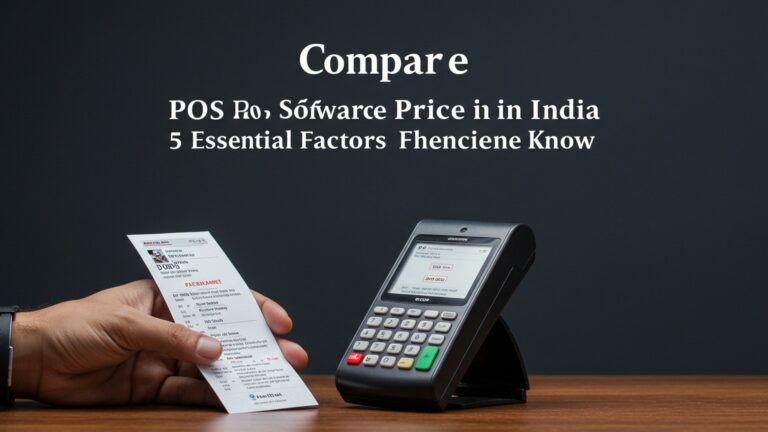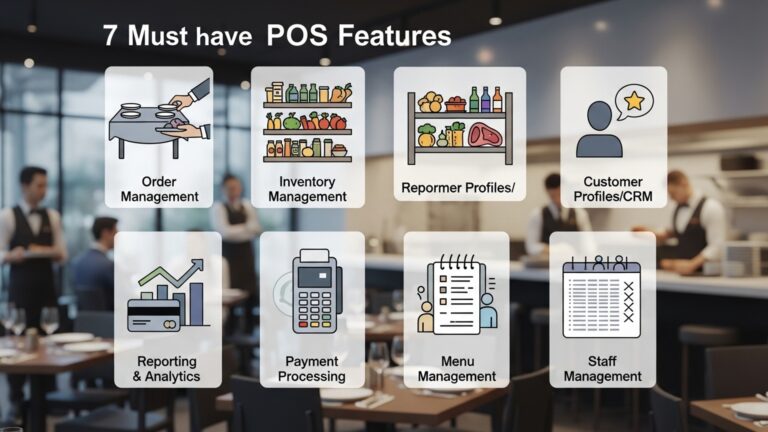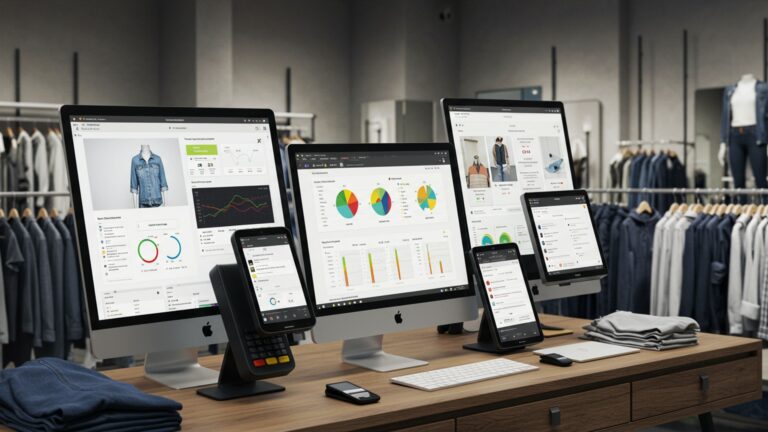Discover 5 Key Strategies to Choose the Best Restaurant POS Software
In today’s hyper-competitive culinary landscape, a robust Restaurant POS software is no longer a mere transaction processor but the central nervous system of your entire operation. The pandemic accelerated a crucial shift, demanding systems that seamlessly integrate online ordering, third-party delivery platforms like DoorDash. touchless payment options, moving far beyond traditional cash registers. Choosing the wrong system, perhaps one lacking real-time inventory synchronization or a scalable cloud architecture, can lead to costly operational bottlenecks and missed growth opportunities. Modern restaurant owners need intelligent POS solutions that provide actionable analytics on peak hours and popular menu items, support dynamic pricing. even manage staff scheduling, transforming raw data into strategic advantage rather than just processing sales. Selecting the optimal platform requires a nuanced understanding of its capabilities to truly elevate efficiency and customer experience.
1. grasp Your Restaurant’s Unique Needs and Operational Flow
Before diving into a sea of features and price tags, the first and most crucial step in selecting the best Restaurant POS software is to conduct a thorough self-assessment of your establishment. Every restaurant is unique, from a bustling fine-dining experience to a quick-service cafe or a multi-location chain. Your Restaurant POS software must be a tailored fit, not a one-size-fits-all solution.
Consider the following aspects:
- Restaurant Type
- Business Size and Scale
- Current Operational Challenges
- Future Growth Plans
Is it a quick-service restaurant (QSR), full-service, bar, food truck, or ghost kitchen? Each type has distinct operational requirements. For instance, a QSR prioritizes speed and efficient order taking, while a full-service restaurant needs robust table management, split checks. reservation integration.
How many locations do you have? What’s your average daily transaction volume? A small cafe might thrive with a basic, user-friendly system, whereas a growing chain will demand advanced reporting, centralized management. scalability features from its Restaurant POS software.
Identify your pain points. Are you struggling with inventory accuracy, long wait times, inefficient staff communication, or cumbersome reporting? The right Restaurant POS software should directly address these challenges, transforming them into strengths.
Think long-term. Do you plan to expand to multiple locations, add delivery services, or introduce a loyalty program? Your chosen Restaurant POS software should be capable of growing with you, avoiding the need for a costly migration down the line. A system that scales effortlessly can save significant time and resources.
For example, a local pizzeria owner, Sarah, found herself constantly battling inventory discrepancies and missed online orders. Her old system couldn’t integrate with her online ordering platform or track ingredients accurately. By investing in a modern Restaurant POS software that offered seamless online order integration and real-time inventory management, she reduced food waste by 15% and saw a 20% increase in online sales. This highlights how a deep understanding of specific needs directly translates into operational improvements.
2. Evaluate Core Features and Functionality
Once you have a clear picture of your operational needs, the next step is to meticulously evaluate the core features and functionality offered by various Restaurant POS software solutions. This is where the rubber meets the road, as the right feature set can significantly streamline operations and enhance customer experience.
Key features to scrutinize include:
- Order Management
- Intuitive Order Entry
- Table Management
- Kitchen Display System (KDS) Integration
- Online Ordering & Delivery Integration
- Inventory Management
- Real-time Tracking
- Recipe Management
- Vendor Management
- Reporting & Analytics
- Sales Reports
- Labor Reports
- Cost Analysis
- Customer Relationship Management (CRM) & Loyalty
- Customer Profiles
- Loyalty Programs
- Employee Management
- Time Clock
- Permissions
- Performance Tracking
Can staff quickly take orders, customize items. apply discounts? Look for a user-friendly interface.
For full-service restaurants, this includes graphical table layouts, reservation integration. the ability to easily split or merge tables and checks.
Essential for efficient communication between front-of-house and back-of-house, reducing errors and improving ticket times.
With the rise of digital orders, your Restaurant POS software should seamlessly connect with your website for direct orders and third-party delivery platforms.
Monitor ingredient levels, track waste. receive alerts for low stock. This is crucial for controlling food costs, which typically account for 25-35% of a restaurant’s revenue.
Standardize recipes and calculate plate costs accurately.
Streamline ordering from suppliers.
Track daily, weekly. monthly sales, identify peak hours. top-selling items.
Monitor employee hours, calculate wages. optimize staffing schedules.
Gain insights into food costs, waste. profitability. Robust analytics from your Restaurant POS software can reveal crucial trends and areas for improvement.
Store customer data, order history. preferences.
Implement points-based systems, discounts, or special offers to encourage repeat business. A well-designed loyalty program can increase customer retention by 5%.
Track employee clock-ins and outs.
Define roles and access levels for different staff members.
Monitor individual server sales and tip management.
When comparing features, it’s helpful to create a checklist based on your needs assessment. Here’s a simplified example of how you might compare two hypothetical Restaurant POS software options:
| Feature Category | Your Restaurant’s Need | POS Software A | POS Software B | Recommendation |
|---|---|---|---|---|
| Online Ordering | Must integrate with website & 3rd party apps | Direct integration only | Direct & 3rd party API | Software B |
| Inventory Management | Real-time tracking, recipe costing | Basic tracking | Advanced tracking, recipe costing | Software B |
| Table Management | Graphical layout, split checks | Yes, basic | Yes, advanced with reservation sync | Software B (for full-service) |
| Reporting | Detailed sales & labor | Standard reports | Customizable, AI-driven insights | Software B |
3. Consider Scalability and Integration Capabilities
A Restaurant POS software system isn’t an isolated tool; it’s the central nervous system of your operation. Therefore, its ability to scale with your business and seamlessly integrate with other essential technologies is paramount. Choosing a system that can adapt to growth and connect with your existing tech stack prevents future headaches and ensures a cohesive operational environment.
- Scalability for Growth
- Easily add new terminals or locations under a single management dashboard.
- Centralize menu management, pricing. promotions across multiple sites.
- Consolidate reporting and analytics for a holistic view of your entire enterprise.
- Handle increasing transaction volumes without performance degradation.
- Integration with Other Systems
- Accounting Software (e. g. , QuickBooks, Xero)
- Payment Processors
- Online Ordering Platforms
- Reservation Systems (e. g. , OpenTable, Resy)
- Employee Scheduling Software
- Loyalty Programs
Your restaurant today might be a single location. what if you plan to open a second or third outlet next year? A scalable Restaurant POS software should allow you to:
Industry experts often advise choosing cloud-based Restaurant POS software for superior scalability, as they can typically handle increased demand more efficiently than on-premise systems.
Modern restaurant operations rely on a suite of specialized tools. Your Restaurant POS software should act as a hub, not a silo. Key integrations to look for include:
Automate daily sales reconciliation, payroll. expense tracking. This saves countless hours of manual data entry and reduces human error.
While many POS systems have built-in payment processing, ensure it supports various payment types (credit cards, mobile payments, gift cards) and offers competitive rates.
Crucial for direct website orders and popular third-party delivery services (e. g. , DoorDash, Uber Eats). Seamless integration means orders flow directly into your KDS without manual intervention.
For full-service restaurants, this ensures table availability is accurately reflected across all channels.
Optimize labor costs by integrating sales data with staffing needs.
Integrate with dedicated loyalty platforms or use the built-in features of your Restaurant POS software to reward repeat customers.
A restaurant owner in Chicago, John, initially chose a basic Restaurant POS software that couldn’t integrate with his accounting system. Every night, his manager spent an hour manually entering sales data. After switching to a system with robust QuickBooks integration, he saved over 30 hours of administrative work per month, allowing his manager to focus on more strategic tasks like staff training and customer engagement. This real-world example underscores the immense value of seamless integration.
4. Assess Support, Security. Reliability
When selecting Restaurant POS software, the quality of support, the robustness of its security features. its overall reliability are often overlooked until a critical issue arises. These factors are foundational to uninterrupted operations and protecting your business and customer data.
- Customer Support
- 24/7 Availability
- Multiple Channels
- Response Times
- Onboarding & Training
- Data Security
- PCI DSS Compliance
- Data Encryption
- User Permissions
- Cloud Security
- System Reliability and Uptime
- Hardware Reliability
- Cloud Uptime Guarantees
- Offline Mode
- Regular Updates
A POS system is mission-critical. When it goes down, your business effectively stops. Therefore, the availability and quality of support are paramount.
Restaurants often operate outside standard business hours. Ensure support is available whenever you need it.
Look for support via phone, email, live chat. a comprehensive knowledge base.
Inquire about typical response and resolution times for urgent issues.
Does the vendor provide adequate training for your staff during setup? Ongoing training resources are also valuable.
A survey by Software Advice indicated that good customer support is a top priority for small business owners choosing software. Imagine a busy Saturday night when your system freezes. Quick, effective support can be the difference between a minor hiccup and lost revenue and frustrated customers.
Your Restaurant POS software handles sensitive data, including customer payment data, sales data. employee details. Protecting this data is not just good practice, it’s a legal and ethical imperative.
Ensure the system and its payment processing are fully compliant with the Payment Card Industry Data Security Standard (PCI DSS) to protect credit card data.
All data, both in transit and at rest, should be encrypted to prevent unauthorized access.
The system should allow you to set granular access controls, ensuring employees only access the insights and functions necessary for their role.
If choosing cloud-based Restaurant POS software, inquire about the vendor’s data center security measures, backup protocols. disaster recovery plans.
A data breach can severely damage a restaurant’s reputation and lead to significant financial penalties. Investing in secure Restaurant POS software is an investment in your brand’s integrity.
An unreliable POS system can be a nightmare. Frequent crashes, slow processing, or unexpected downtime can disrupt service, frustrate staff. drive customers away.
If proprietary hardware is involved, assess its durability and warranty.
For cloud-based systems, inquire about the vendor’s guaranteed uptime (e. g. , 99. 9% uptime).
Some Restaurant POS software offers an “offline mode” allowing transactions to continue even if the internet connection is temporarily lost, syncing data once connectivity is restored. This is a critical feature for business continuity.
Ensure the vendor provides regular software updates for new features, security patches. performance improvements.
Choosing a reputable vendor with a proven track record for stable and reliable Restaurant POS software minimizes operational risks and ensures smooth service delivery.
5. review Pricing Models and Total Cost of Ownership (TCO)
The final. by no means least essential, strategy involves a meticulous examination of the pricing models and the overall Total Cost of Ownership (TCO) for any Restaurant POS software under consideration. Sticker price alone can be misleading; understanding all associated costs is vital for accurate budgeting and long-term financial planning.
- Understanding Pricing Models
- Subscription-based (SaaS)
- One-time Purchase (On-premise)
- Hybrid Models
- Hidden Costs to Uncover
- Hardware Costs
- Payment Processing Fees
- Installation & Setup Fees
- Training Fees
- Integration Fees
- Support & Maintenance Contracts
- Upgrade Fees
- Calculating Total Cost of Ownership (TCO)
Restaurant POS software typically comes with various pricing structures:
This is the most common model, where you pay a monthly or annual fee per terminal or location. This often includes software updates, support. cloud hosting. It provides predictable operating expenses.
Less common now, this involves an upfront lump sum for the software license. You typically own the software. may need to pay extra for updates, support. hardware maintenance.
Some vendors might offer a low monthly software fee but charge higher transaction processing fees or require proprietary hardware purchases.
Beyond the advertised price, several other factors contribute to the TCO of your Restaurant POS software:
Do you need to purchase proprietary terminals, receipt printers, cash drawers, or kitchen display screens? Or can you use off-the-shelf iPads or Android tablets? These costs can range from a few hundred to several thousand dollars per setup.
This is a significant ongoing cost. interpret the percentage per transaction, any flat fees, PCI compliance fees. chargeback fees. Negotiate these rates if possible. Some POS providers bundle processing, others allow you to choose your processor.
Some vendors charge for initial setup, data migration. on-site installation.
While some basic training may be included, extensive or customized training sessions might incur additional costs.
Connecting your Restaurant POS software to third-party apps (accounting, online ordering, loyalty) might involve API access fees or connector costs.
For one-time purchase models, ongoing support and software updates are often separate, recurring costs.
Be clear on whether future major software upgrades are included in your plan or require additional payment.
To get a realistic financial picture, create a spreadsheet that projects all these costs over a 3-5 year period. This allows for an apples-to-apples comparison between different Restaurant POS software options.
Example TCO Calculation (Annualized for a single restaurant):
Annual Software Subscription: $1,200 (e. g. , $100/month) Hardware Depreciation (over 3 years): $500 (e. g. , $1500 hardware / 3 years) Payment Processing Fees (estimated): $1,800 (e. g. , 2% of $90,000 annual card sales) Support/Maintenance (if separate): $200 Integration Costs (annualized): $100 ------------------------------------------------ Estimated Annual TCO: $3,800
A restaurateur in New York, after careful TCO analysis, chose a Restaurant POS software with a slightly higher monthly subscription but significantly lower payment processing fees and no hidden integration costs. Over five years, this decision saved him nearly $10,000 compared to a seemingly cheaper alternative, demonstrating the power of looking beyond the initial price tag.
Conclusion
Choosing the right restaurant POS software is a pivotal strategic decision, not merely a transactional one. It’s about future-proofing your operations and empowering your team. Don’t just compare feature lists; envision your busiest Saturday night and how each system would actually perform under pressure, from speedy order entry to seamless payment processing. My personal tip? Always run a real-world trial with your actual staff, not just a vendor demo, to truly gauge user-friendliness and integration with your unique workflow. Consider how modern cloud-based solutions, a significant industry trend, offer unparalleled flexibility and remote management capabilities that legacy systems simply can’t match, ultimately enhancing your restaurant’s overall efficiency and customer experience. A well-chosen POS isn’t just software; it’s the operational backbone that empowers your team, streamlines service. provides invaluable data insights for growth. Embrace this investment. you’ll unlock unprecedented levels of productivity and profitability, transforming challenges into opportunities for excellence. For further insights into industry best practices, you might find valuable data on resources like the National Restaurant Association’s tech guides.
More Articles
How to Create an Effective Restaurant Marketing Plan
The Ultimate Guide to Restaurant Inventory Management
Boost Your Restaurant’s Profitability: A Guide to Cost Control
Essential Restaurant Tech Tools for Modern Operations
The Future of Dining: Trends Shaping the Restaurant Industry
FAQs
Why is picking the right POS software so essential for my restaurant?
Choosing the right POS is crucial because it’s the heart of your operations. It impacts everything from order taking and payment processing to inventory management and customer service, directly affecting efficiency, profitability. guest experience.
How do I figure out what features my restaurant actually needs in a POS system?
Start by listing your daily operations and pain points. Are you a quick-service spot needing fast order entry, or fine dining requiring detailed table management? Consider if you need online ordering, delivery integrations, inventory tracking, staff management, or loyalty programs. Don’t pay for features you won’t use.
My staff isn’t super tech-savvy. How can I ensure the POS won’t be a nightmare to learn?
Look for systems with intuitive interfaces and minimal training requirements. Many modern POS solutions are designed to be user-friendly, similar to using a tablet or smartphone. Ask about demo availability and onboarding support to gauge how easy it will be for your team to pick up.
What about costs? Are there hidden fees I should watch out for when buying POS software?
Absolutely, always dig into the total cost of ownership. Beyond the software subscription, consider hardware costs, installation fees, payment processing rates, ongoing support plans. any potential upgrade charges. A seemingly cheap initial price can quickly add up with hidden extras.
My restaurant is growing fast. How do I make sure the POS I choose can keep up?
Prioritize scalability. Look for cloud-based systems that can easily add more terminals, locations, or features as your business expands without needing a complete overhaul. Check if it integrates well with other tools you might adopt later, like advanced accounting or marketing platforms.
What kind of support should I expect from a POS provider if something goes wrong?
Good support is non-negotiable. Check their availability (24/7 is ideal for restaurants), response times. the channels they offer (phone, chat, email). Read reviews about their support quality; you don’t want to be left stranded during a busy shift.
Is a cloud-based POS really better than an older, on-premise system?
Generally, yes. Cloud-based systems offer real-time data access from anywhere, automatic updates, better data security. lower upfront hardware costs. They’re also typically more resilient to local hardware failures and easier to scale compared to traditional on-premise setups.





